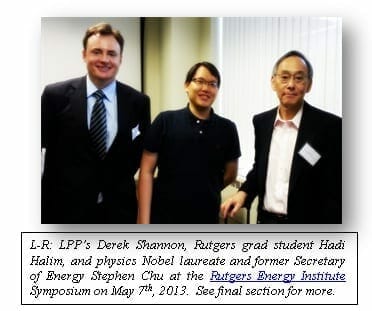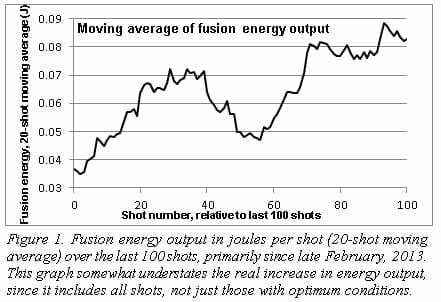Summary:
- Plasmoid density triples, fusion energy rises with purer plasma

- But not pure enough—LPP tracks down what disrupted the filaments
- LPP has new paper for Spain conference
- US Department of Commerce finds all in order with LPP-Iran Scientific “Fusion for Peace” Collaboration
- LPP has rendezvous with Chu as Congress sets eye on ITER costs
Plasmoid density triples, fusion energy rises with purer plasma
The density of the fusion-producing plasmoid is the key factor that must be increased for LPP to demonstrate the scientific feasibility of net energy production from Focus Fusion—net energy meaning more energy out than is lost in making that energy. In the past month’s experiments, LPP’s research team has demonstrated the near-tripling of ion density in the plasmoid to 8×1019 ions/cc, or 0.27 mg/cc. At the same time, fusion energy output has moved up, with the best three-shot average increasing 50% to one sixth of a joule of energy. These results are not flukes, but part of an upward trend in density and energy since late February (see Figure 1), as the team reduced leaks in the vacuum chamber by over a hundred-fold. This reduced impurities entering the plasma from insulating oxide layers on the electrodes, thus improving the compression of the plasma. In addition, at the end of March, LPP’s Derek Shannon refurbished the switches on FF-1, replacing worn plastic insulation, thus allowing the switches to fire in closer coordination.
The greater increase in density than fusion energy is expected, because as compression improves and the plasmoid gets smaller, its lifetime also decreases. So while density improves roughly as 1/r3, where r is radius, lifetime decreases proportional to r and energy output increases roughly as the product of the two, or 1/r2.
The higher density was determined by combining measurements of the total fusion energy and ion temperature derived from our neutron detectors, and measurements of plasmoid size from our ICCD-camera images. The LPP team has moved the camera to a new position, looking up close to the axis of the electrodes instead of side-on as previously (see next section). Our very first image from this direction (Figure 2) shows our smallest plasmoid yet observed with a core radius of only150 microns and core length of about 1.5 mm.
See full report here.


